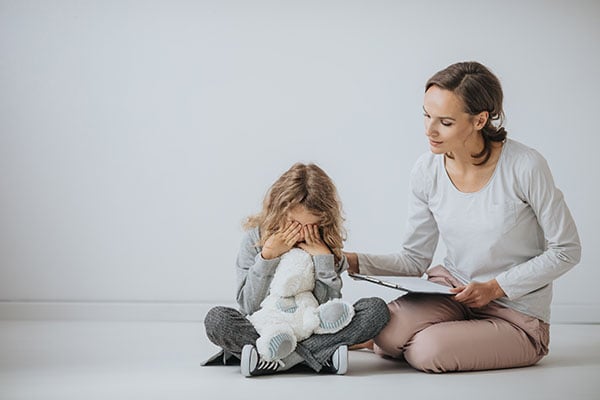By: Melanie Koenig August 5, 2025
If you’ve ever found yourself in the middle of Target with a child melting down over a squished granola bar—or if your child has been increasingly anxious but you can’t quite get them to open up—you’re not alone.
I asked the moms in Sauk County Mom Community what subject(s) they would like me to discuss with Kate Fitzpatrick, MS, Licensed Professional Counselor & Pediatric Counselor at Reedsburg Area Medical Center, and the highest votes were meltdowns and anxiety.
Meltdowns Aren’t Misbehavior
First up in my conversation with Kate was meltdowns. Right away Kate acknowledged that meltdowns can feel overwhelming for everyone, but meltdowns aren’t signs of defiance–they’re usually signals that a child’s nervous system is overwhelmed. Since young children’s brains aren’t yet developed enough to regulate big emotions on their own, everything from hunger and tiredness to overstimulation and disconnection can spark a meltdown. It’s less about defiance and more about a stress response.
What Can We As Parents Do During a Meltdown?
Parents often want to explain, comfort, or even lecture in the middle of a meltdown but kids aren’t in a place where they can process language. Phrases like “You’re fine” or “It’s not a big deal” can feel dismissive, even if the intention is to soothe. Kids in the middle of a meltdown need safety and support, not logic or discipline. A better approach is to get down to their level and offer steady, quiet support until the storm passes. This kind of connection helps bring their nervous system back into balance.
Handling Meltdowns at Home and in Public
In public settings, it’s natural to feel embarrassed or flustered but staying calm yourself is one of the best things you can do. If possible, try to move to a quieter spot and help your child regulate by modeling slow, steady breathing.
At home, Kate suggested creating a designated calm-down space with soft pillows, stuffed animals, or sensory items which can give kids a safe place to regroup when needed.
And if you lose your cool in the moment (which happens to all of us), that’s okay. Repair matters. Coming back later to reconnect and say, “Let’s try again next time,” can help build trust and resilience for both of you and models accountability.
Common Triggers of Meltdowns in Children
We often expect meltdowns after a skipped nap or an extra-busy day but there are plenty of smaller, easy-to-miss triggers too. It might be something as minor as scratchy socks, a crowded room, or a change in routine. Kids are incredibly sensitive to their environments, including the stress levels of the adults around them.
That’s why Kate encourages parents to look beyond the surface and consider what their child might be experiencing physically or emotionally. When we can understand the “why” behind a meltdown, we’re better equipped to respond with empathy instead of frustration.
Prevention Strategies
To help prevent meltdowns, it can be useful to build in routines and transition cues. Giving your child a simple heads-up (“We’re leaving the park in five minutes”) and offering small choices (“Do you want to walk to the car or do you want me to carry you?”) gives them a sense of control.
What About Timeouts and Consequences?
Discipline after a meltdown can be tricky. According to Kate, what most kids need after a big emotional moment isn’t a consequence…it’s connection. A calming break (rather than a punitive timeout) can help them recover, especially if it’s framed as a way to feel better rather than something they’re sent to do as punishment.
Let’s Talk About Anxiety
Understanding Anxiety in Kids
It’s common for parents to notice signs of anxiety without knowing how to help. Creating space for low-pressure conversations—like while coloring or driving can help kids open up.
Kate recommends using indirect ways to explore feelings, like talking about a character in a book or playing alongside your child while gently wondering out loud about how that character might be feeling. Saying things like “I wonder if he felt nervous when he had to do that?”. The key is keeping it low-pressure and conversational. Using the word ‘wonder’ invites them in without demanding a response.
Are You Accidentally Reinforcing Anxiety?
It’s only natural to want to reassure your child or swoop in to fix things when they’re scared or upset. But sometimes, constant reassurance can unintentionally reinforce their worry. When a child says, “I can’t do it,” and we respond with “Yes, you can!” we may be skipping the opportunity to help them build confidence in facing challenges.
Avoiding situations that make them anxious might work temporarily, but it doesn’t teach long-term coping. Helping kids feel safe while still moving through discomfort is one of the best ways to support their growth.
This part of our conversation reminded me of when I spoke with Liv Nelson and she suggested the book “Good Inside” by Becky Kennedy.
When to Seek Help
Not all worry is a cause for concern but if anxiety begins to interfere with daily life (like avoiding school, trouble sleeping, or frequent outbursts), it might be time to connect with a professional. You don’t need to wait until things feel urgent. Counseling can be a helpful tool for kids and parents alike, even as a preventive step.
The Bottom Line
Meltdowns and anxious moments are part of the parenting journey and not a sign that something’s wrong with you or your child. As Kate reminds us, offering connection, calm, and compassion can make all the difference. And if it ever feels like too much, there are resources and professionals who are ready to walk alongside you.
This article is for informational purposes only and is not a substitute for professional medical or mental health advice. If you have concerns about your child’s emotional well-being, please reach out to a licensed provider such as the team at Reedsburg Area Medical Center or another trusted professional.







